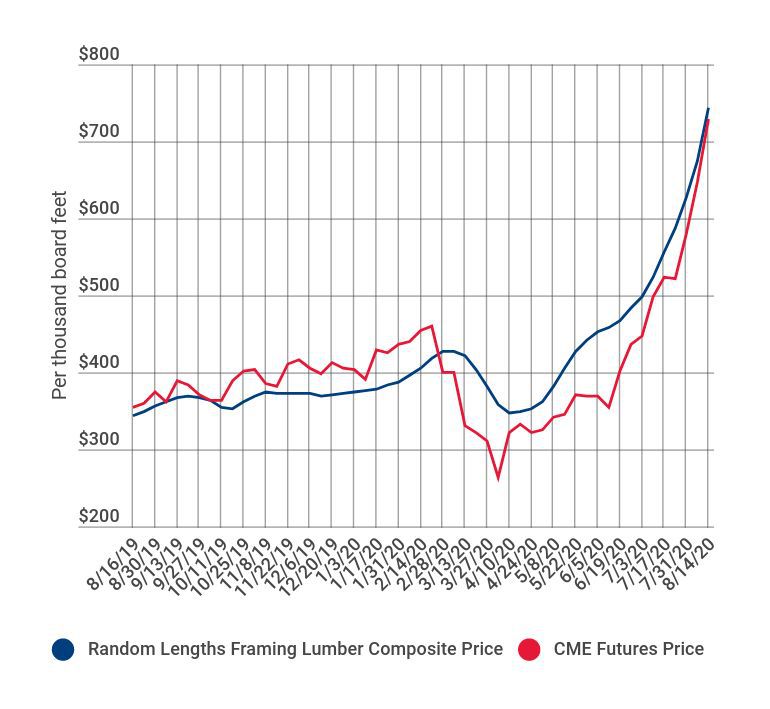If you’re a regular purchaser of lumber, or products made from lumber, you’ve almost certainly noticed the huge price increases over the last few months. According to National Association of Home Builders, prices are up nearly 80% since April, and that kind of surge creates a lot of rumors and speculation.
You’ve probably heard the rumors too. Some people think that companies are simply trying to beef up their profit margins to make up for losses from the mandatory shutdowns. Others think that mills and lumber producers are purposely shorting supply to create a bubble from which they can profit.
Rumors, Rumors, Rumors
Honestly, we hear some of those same rumors from our customers and prospects too.
Here at Conner, we’re not financial or market experts, but we know lumber. We speak to our partner mills and many others in the industry every day, and we’re all just trying to wade through this difficult time the best that we can.
We’ve seen absolutely no evidence that anyone is trying to price gouge on lumber. It has become very competitive to get southern yellow pine (SYP), which means that prices are sometimes changing hourly. Adequate supply is still a big issue for lumber.
Fortunately, we have such good relationships with mills and treaters that our partners are doing their best to work with us and cut us (and our customers) a break on price whenever they can. But let’s be honest, there is only so much they can do when there’s not enough lumber to go around.
So that’s one rumor down – Lumber producers are not purposely shorting lumber supply.
That brings us to the other big rumor about companies padding their margins to make up for losses during COVID. While we certainly can’t speak for other companies, we can tell you that Conner has significantly cut margins to share the lumber price pain with our customers. We want to keep our valuable customers, and the only way to do that is to do the right thing. With lumber prices being at record highs, the shortages and pricing are hurting us too.
So, Why Are Lumber Prices REALLY So High?
Now that those rumors are out of the way, we can discuss the actual reasons why lumber prices are near record levels. The fact is that even after three consecutive record-breaking weeks, SYP is showing no signs of coming back down yet. Supply and demand are completely out of sync, and the pandemic is the reason why, but it’s complicated by a lot of different factors.
DIYers Hit Lumber Hard
We already talked about how the nation’s DIYers have hit lumber hard during the pandemic. All that do-it-yourself activity, along with the fact that the big box retailers were designated ‘essential businesses’ during the shutdowns, really did a number on the nation’s lumber inventory during the height of the pandemic.
To make matters worse, lumber mills shut down due to infection concerns and the shutdowns in the early days of the pandemic. No one expected the DIY surge, and housing construction was grinding to a halt, so it made sense that the demand for lumber would taper off.
With such an unprecedented situation, no one could have guessed that the demand for lumber would skyrocket. In case you’re wondering if the hype around DIY demand is true, take a look at some of these statistics.
The big box stores reported record profits during the shutdown months. Lowe’s second-quarter revenue surged by 30% and their profit jumped a whopping 68.7%, according to CNBC. The Home Depot said that “it’s quarterly sales soared by 23% as consumers stuck in the house during the coronavirus pandemic built decks, painted their walls, and tackled other repairs.”
Make no mistake, DIY hit the lumber market very hard and decimated the available lumber inventory.
Then We Started Building Again
As the country started to open back up and people went back to work, the construction industry began building again. Housing starts surged by 17% in June 2020, month over month. In July 2020, new construction surged again by 22.6% over June – well above market forecasts.and now we’re all paying the price.
source: tradingeconomics.com
(Keep in mind this doesn't include August.)
A lot of really smart people expected the housing market to crash, instead it did the opposite. With record low interest rates and a lot of people spending more time at home than ever before, the housing market is booming in many areas across the country. It’s shaping up to be one of the busiest construction seasons in years.
That put even more pressure on the lumber industry. Builders currently have to search harder and pay more to get the materials they need. In many cases, lumber orders are weeks out. The North American sawmill supply chain is under a tremendous amount of pressure to keep up with demand, and that has pushed the price of lumber to record levels. For the week ending August 14, 2020, the composite price of SYP increased 39% over the previous all-time high in June 2018.
Historically, housing starts have been the main driver of lumber prices in the U.S. We already know that the unprecedented DIY market and the pandemic flipped all that on its head for months. Now that housing starts are surging with stronger than expected demand, combined with the surge at big box stores, the normally well-oiled lumber supply chain has not been able to catch up.
Predictions about demand and the impact of the pandemic were made months ago. Unfortunately, the predictions were all wrong, and now we’re all paying the price.
What About Speculators?
Since lumber is a commodity, it’s fair to say that speculators have also gotten involved in the lumber market. For businesses who typically buy their lumber inventories weeks in advance, the current situation has resulted in some panic buying as they try to stay ahead of the competition, gain a share of limited inventories, and try to maintain their build schedules. Unfortunately, when this kind of panic gets ahold of any commodities market, speculators often get involved and can affect prices.
With such a large supply gap in the market, it’s likely that volatility will remain until the supply and demand equalize.
When Will It End?
Without a doubt, 2020 has been a year of unprecedented events. The series of events that got the lumber market to where it is now is just another unprecedented event to add to the list this year. The real question is when will prices come back down or at least stop climbing?
No one really expected lumber prices to climb as high as they already have, and the truth is that no one really knows how high lumber prices will get or when this surge will end. It all depends on the equilibrium between supply and demand. Until the supply of lumber available equals or exceeds the demand for lumber, prices will remain high. According to experts, we can expect lumber prices to remain high throughout the remainder of 2020, and many expect the run on lumber to carry over into early 2021.
One thing is for sure – high lumber prices will eventually come to an end. Once supply and demand equalize, building slows, and the lumber supply chain catches up, we should see prices come back down to normal levels.
In the meantime, hardwoods might be a possible solution to fit your short-term needs. In most cases, hardwood isn’t surging the way SYP is right now.



![[PRESS RELEASE] Conner Industries Announces Website Dedicated to Integrated Packaging Division](https://conner.b-cdn.net/wp-content/uploads/2024/05/Conner-Packaging-Blog-500x383.jpg)



